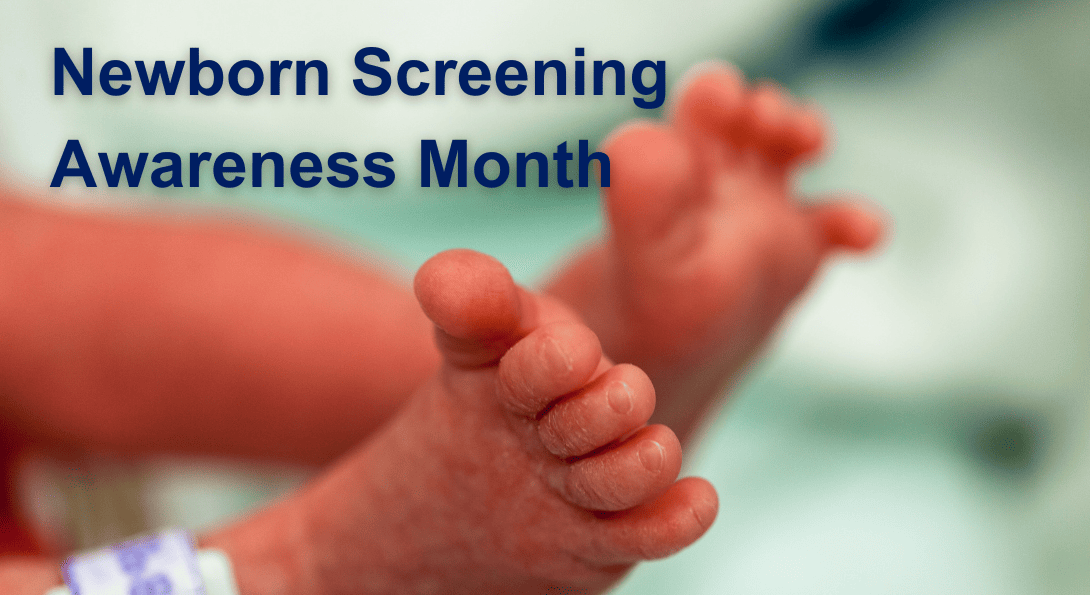Celebrating Newborn Screening Awareness Month

Illinois' Newborn Screening Program Enters its 60th Year
SPH Professor Remarks on NBS

“In 2025, the 60th anniversary of Newborn Screening in Illinois will be recognized. The public health community often talks about its responsibility to [each other…] to speak for those who have no voice, to take action to save lives and to take theoretical knowledge and apply it to practice. What better example to offer than that of celebrating the 60 years of Newborn Screening?”
Dr. Petros served 38 years at the City of Chicago and State of Illinois public health laboratories, first as a senior microbiologist in serology/virology and later, as chief of operations for newborn screening.
| Clinical Assistant Professor, Division of Environmental and Occupational Health Sciences, Doctor of Public Health Program Advisor
Learn About Newborn Screening
What is Newborn Screening?
Newborn Screening (NBS), a core function of state health departments, is the process of testing newborn babies for treatable genetic, metabolic, endocrine, and hematologic disorders. Advances in technology have made screening for more than fifty disorders possible using a single dried blood sample. Newborn Screening is an essential component of the global public health system.1
Why is Newborn Screening Important?
Many of the disorders identified through NBS are potentially fatal conditions that are not otherwise apparent at the time of birth. Early detection, diagnosis, and treatment of these conditions can prevent death or disability and enable children to reach their full potential. Each year in the United States, approximately 12,000 of the 4 million newborns screened are identified through NBS as potentially having one of these conditions.2
How was Newborn Screening Developed?
In 1965, NBS in Illinois began by testing for Phenylketonuria (PKU), a metabolic disorder that results in the accumulation of phenylpyruvic acid instead of being fully metabolized. If unidentified soon after birth and left untreated, PKU leads to irreversible neurological damage.
Robert Guthrie MD, PhD (1916 –1995) a microbiologist at the State University of New York-Buffalo, developed the test used to screen newborn infants for phenylketonuria (PKU) that is still successfully used today. Guthrie conducted his research to develop a test that would allow for early identification, that is, before irreversible neurological damage had taken place.
When NBS first emerged as a groundbreaking, doable public health effort, the common name for the screening was referred to as “the PKU test” or “the Guthrie test”. Now, the typical screening panel consists of more than 40 conditions, including cystic fibrosis, sickle cell disease, congenital hypothyroidism, and severe combined immunodeficiency.
What is the role of public health in Newborn Screening?
Newborn screening is widely recognized as a highly successful health promotion and disease prevention public health program. State health departments were among the first to recognize the importance of NBS to public health, and NBS has been an established public health function for many years.3,4 NBS has become a world-wide endeavor of state, local, and national public health agencies and systems. The goal of screening is to identify those infants in the newborn population that are most likely to have disease, so that once identified, the following can occur: diagnostic testing, case monitoring, referral for treatment, genetic counseling and long-term follow-up services. This work is carried out by public health agencies and partners.
NBS Programs are examples of public–private partnerships that are designed to achieve specific goals of the public health system. NBS Programs operate under public health law (and/or administrative rules) to identify infants in the newborn population that require follow-up testing for timely interventions to take place. In turn, the registry operated by the NBS Program case management staff ensures continuum of care for the infants and their families. Counseling is provided to the family as well as information on long-term care for the patient.5
Learn more about NBS by visiting IDPH and CDC
_________
- Petros, M. Revisiting the Wilson-Jungner criteria: how can supplemental criteria guide public health in the era of genetic screening? Genetics in Medicine, Volume 14, Number 1, 129-134. January 2012
- Brower, A, et al. Population-Based Screening of Newborns: Findings From the NBS Expansion Study (Part One), Frontiers in Genetics, 22 July 2022, doi: 10.3389/fgene.2022.867337
- MacCready, RA, Hussey, MG, Newborn Phenylketonuria Detection Program in Massachusetts, Progress Report, State Health Department, December 1964, 2075-2081
- Levy, H.L., Newborn Screening Conditions: What we know, What we do not know, and how we will know it, Genetics in Medicine, Vol. 12, No. 12, December 2010 Supplement S213-214
- Chan K, Petros M. Simple Test, Complex System: Multifaceted Views of Newborn Screening Science, Technology, and Policy. Glob Pediatr Health. 2019 Dec 20;6:2333794X19894812. doi: 10.1177/2333794X19894812. PMID: 31903414; PMCID: PMC6926981.